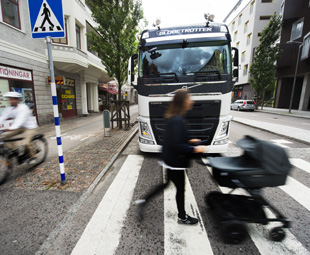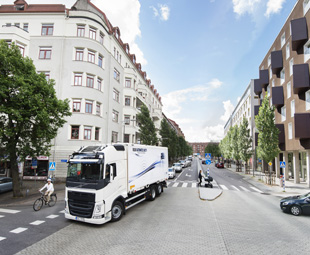Clairvoyant commercial vehicles

There’s no doubt about it – trucks are a lot smarter nowadays. They can even drive themselves. Thanks to Volvo Trucks, however, these workhorses will take things a step further and become soothsayers!
The technology behind it all is the result of the research project Non-Hit Car and Truck, undertaken in cooperation with Volvo Cars. It is intended to dramatically reduce the risk of accidents, caused by a limited field of vision, by enabling a vehicle to do a 360-degree scan of its surroundings.
“The vehicle evaluates information from multiple sources simultaneously, functioning much like the human mind does, and suggests actions to avoid any incidents,” the company points out. “If the driver does not respond to the suggested actions, the steering or braking system can be activated autonomously.”
At the heart of it all is a data platform that fuses the sensory input from cameras, radars and other sensors positioned on all sides of the vehicle. This enables the truck to perform a 360-degree scan of its surroundings every 25 milliseconds. All the data input is interpreted, risk situations are analysed and different route options for the vehicle are generated.
 “The technology can predict traffic scenarios up to five seconds ahead – depending on the speed of the objects – and map out the best plan of action,” says Mansour Keshavarz, systems engineer at Volvo Trucks, who has worked with the technology.
“The technology can predict traffic scenarios up to five seconds ahead – depending on the speed of the objects – and map out the best plan of action,” says Mansour Keshavarz, systems engineer at Volvo Trucks, who has worked with the technology.
“In many ways, the technology serves as a co-driver – but one that can see all around the vehicle. It can also alert the driver to things that are happening so that he or she can react; for example, by warning with an alarm signal or braking to avoid a collision.”
It will be a while longer before clairvoyant driving can be found on public roads, however, as the technology is not yet ready to be applied in a commercial safety system.
“Trucks are a different type of vehicle and do not act the same way as cars in traffic,” says Keshavarz. “Each truck is loaded differently, for example, and their large size prevents them from carrying out severe avoidance manoeuvres – such as swerving quickly.”
According to Carl Johan Almqvist, traffic and product safety director at Volvo Trucks, market introduction could take place within five to ten years. “We have the main components in place, but we need to do a lot more testing in order to make sure that the system is fault free. If we manage to solve these challenges, a future without truck accidents is within reach.”
Published by
Focus on Transport
focusmagsa




